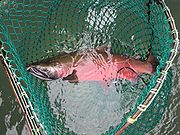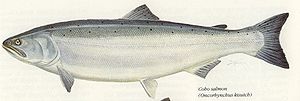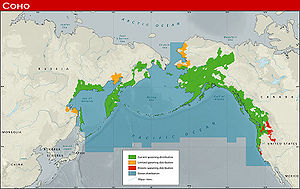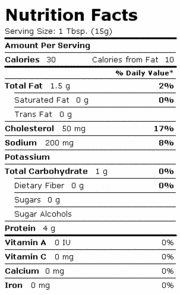Oncorhynchus kisutch
From marinelife1011
Coho salmon Oncorhynchus kisutch is one of 7 anadromous Pacific salmon species. They are commonly referred to as silver salmon or just silvers and sometimes called bluebacks in British Columbia.
| Silver Salmon | |
|---|---|
 |
|
| Scientific classification | |
| Kingdom: | Animalia |
| Phylum: | Chordata |
| Subphylum: | Vertebrata |
| Superclass: | Gnathostomata |
| Class: | Actinopterygii |
| Subclass: | Neopterygii |
| Order: | Salmoniformes |
| Family: | Salmonidae |
| Genus: | Oncorhynchus |
| Species: | kisutch |
| Binomial name | |
| Oncorhynchus kisutch Walbaum, 1792 |
|
Contents |
Description
Morphology
At sea coho salmon are metallic blue above and silvery below with black spots on the back and upper part of the caudal fin. Their gums are white at the base and can be used to differentiate them from Chinook salmon which is a similar looking species but has a black mouth. During spawning males are dusky green on upper back and head bright red on the side, often blackish below; females are brinze to pinkish red on the side.[1]
Evolution
Coho probably split off from the other species of Pacific salmon about 6 million years ago and were most likely a freshwater species that learned to use the sea to their advantage. Surprisingly mitochondrial DNA has shown that coho are more closely related to Chinook and rainbow trout, then they are to sockeye, chum, and pinks. [2]
Reproduction
Fecundity
Female coho carry anywhere from 2000 to 5000 eggs and the eggs are about 4.5-6 mm in diameter. The range is due to the fact that there is higher fecundity in coho as you move north and also with total length of the fish. [2]Groot, C. Margolis, L. (1991). Pacific salmon life histories. Vancouver, B.C.: Univ. of British Columbia Press.</ref>
Spawning
They tend to spawn in small streams of moderate gradient along the coast of the interior. [2] They usually spawn between November and January although there are exceptions. The female will start to dig a redd, this may take about 5 days and males do not help in this process. A male will come to the side of a female and start to court her by crossing-over the caudal tail of the female and quivering. The male will also attempt to use aggression to run off other males. When the female decides to release her eggs, the male comes to her side, they both quiver with mouths gaped open, and the male releases milt. At this point any satellite males in the area may try to “sneak” in and release milt as well. The female then covers the eggs by lightly digging and will guard the redd until she dies and the male will continue to try to spawn with other females until he dies.[2]Groot, C. Margolis, L. (1991). Pacific salmon life histories. Vancouver, B.C.: Univ. of British Columbia Press.</ref>
Life in Freshwater
Emergence
They are about 30 mm when they emerge from the gravel and have heavier bodies then other salmon except Chinook, with more color. [2]
Residence
They usually stay in streams for one to two years, some leave as fry during their first spring. [2] Residuals in coho salmon are rare but have been reported, this term is used for salmon that spend their entire life in freshwater like kokanee. [3] In fresh water, coho feed on plankton and insects; when in the ocean, they switch to a diet of small fishes such as herring, sandlance, anchovies, and sardines. They are also known to eat juveniles of other salmon species, especially pink and chum salmon, and juvenile sablefish. [4]
Smolt Migration
Coho can head to sea from the age of zero (first spring) up to age three, but usually head out after one to two years in their stream. On average they weigh 18 grams when they enter the ocean. [2]Smolts do not spend much time in estuaries. As subadults the usually feed in coastal waters. [2]
Life in the Ocean
Most spend two summers at sea, some return after just one year and are referred to as jacks. The average adult in the ocean is 3.02 kg. [2]
Ecology and Distribution
Geographic Range
They range from Korea and to Arctic Alaska south to Santa Cruz California.[5] The populations in Japan are not self-sustaining but there are large populations in Russia on the Kamchatka Peninsula and the Sea of Okhotsk. Their southern most location in the United States is Scott Creek CA. They can be found all along the coast up to the Norton Sound in AK., with small populations in the artic up to Point Hope AK. [2]
Habitat
Coho juveniles usually occupy the best feeding and cover in streams when compared with trout and chinook salmon. The presence of large trees along a stream also greatly increases production in coho salmon.[6]
Homing and Straying
Homing in coho salmon is best described using the Scholz et al. (1976) study. The study took coho reared in Wisconsin hatcheries that were not part of Lake Michigan. They were then exposed to PEA or morpholine or nothing for the control group. They were all released in Lake Michigan at the same location. A year and half later morpholine was released into the Little Manitowoc River and PEA was released into Two Rivers. 96.6% of the fish that were imprinted with morpholine went to the Little Manitowoc and 92% of the fish imprinted with PEA went to Two Rivers. The control was scattered between the two sites, other sites, and only 2.8% returned to the release site. [7] This study shows that salmon use ordors to find their home stream. There is also some evidence that genetics may play some role, studies have had fish that were imprinted at a hatchery from eggs way up river and passed the hatchery to goto the historic spawning area, even though they had never been there before. [2] 1% to 5% of salmon stray, it is not known if the decision to stray is a mistake or if they are settling new homes. It has made salmon very successful and allowed them to spread after the glacier sheet sup seceded. [2] Some hatchery fish seem to stray over 10%, this is cause for alarm since hatcheries want to control these as much as possible.
Conservation
Conservation Status
Data Taken from a coded wire tag study (CWT) done in 2002 showed that there were over 62 hatchery bred coho in the Puget Sound and only 26 wild populations[8]
Coho salmon are a species of concern as of April 15, 2004, because of specific risk factors. A petition to list Puget Sound coho determined on July 6, 2010, to not present substantial evidence to indicate that the petitioned action may be warranted. The evolutionarily significant units (ESU) includes all naturally spawned populations of coho salmon from drainages of Puget Sound and Hood Canal, the eastern Olympic Peninsula (east of Salt Creek), and the Strait of Georgia from the eastern side of Vancouver Island and the British Columbia mainland (north to and including the Campbell and Powell Rivers), excluding the upper Fraser River above Hope.[9]
Human Use
The United States and Canada cooperate in the sustainable management of Pacific salmon fisheries through the Pacific Salmon Treaty. Coho salmon is low in sodium, a good source of omega-3 fatty acids, and a very good source of protein, niacin, vitamin B12, and selenium. For more on nutrition, see Nutrition Facts. (USDA) The U.S. coho salmon harvest was down about 12% in 2009, totaling 32.9 million pounds. Most of the coho in the U.S. market are caught off of Alaska with a smaller amount from Washington and Oregon. We also import coho salmon, mainly from Canada and Chile.[10]
References
- ↑ Page, L.M., and Burr, B.M. (1991). A Field Guide to Freshwater Fishes. New York: Houghton Mifflin Company.
- ↑ 2.00 2.01 2.02 2.03 2.04 2.05 2.06 2.07 2.08 2.09 2.10 2.11 Quinn, T. P. (2005). The Behavior and Ecology of Pacific Salmon and Trout. Seattle: University of Washington Press.
- ↑ Groot, C. Margolis, L., Clarke, W. (1995). Physiological ecology of Pacific salmon. Vancouver: UBC press.
- ↑ NOAA. (2010, Oct 18). Fish Watch - U.S, Seafood Facts. Retrieved 11 2011, Feburary, from National Oceanic and Atmospheric Administration: http://www.nmfs.noaa.gov/fishwatch/species/coho_salmon.htm
- ↑ Eschmeyer, W. A., and Heral, E.S. (1983). A Field Guide to Pacific Coast Fishes. New York : Houghton Mifflin.
- ↑ Peter B. Moyle, J. J. (2004). Fishes: An Introduction to Ichthyology. San Francisco: Pearson Benjamin Cummings.
- ↑ Scholz, A. H., Horrall, R.M., Cooper, J.C., Hasler, A.D. (1976). Imprinting to chemical cues: the basis for homestream selection in salmon. Science , 1247-1249.
- ↑ Weitkamp, L. and Neely, K. (2002). Coho salmon (Oncorhynchus kisutch) ocean migration patterns: insight from marine coded-wire tag recoveries. Can. J. Fish. Aquat. Sci. 59: , 1100-1115.
- ↑ NOAA. (2008, Feburary 11). Northwest Regional Office. Retrieved 11 2011, Feburary, from NOAA'S Naational Marine Fisheries Service: http://www.nwr.noaa.gov/ESA-Salmon-Listings/Salmon-Populations/Coho/Index.cfm
- ↑ NOAA. (2010, Oct 18). Fish Watch - U.S, Seafood Facts. Retrieved 11 2011, Feburary, from National Oceanic and Atmospheric Administration: http://www.nmfs.noaa.gov/fishwatch/species/coho_salmon.htm
External Links
- http://en.wikipedia.org/wiki/Coho_salmon
- http://www.nwfsc.noaa.gov/publications/techmemos/tm24/tm24.htm
- http://www.salmonnation.org/fish/meet_species.html#]
- http://www.nwr.noaa.gov/ESA-Salmon-Listings/Salmon-Populations/Coho/
- http://www.nmfs.noaa.gov/fishwatch/species/coho_salmon.htm
- http://www.fish.washington.edu/people/tquinn/publications.pdf
- http://www.eoearth.org/article/Salmon_decline_in_western_North_America:_historical_context
- http://www.sf.adfg.state.ak.us/Static/statewide/aquatic_ed/adfgTeacherGuide/tguide_intro.html
- http://govdocs.evergreen.edu/quickref/salmon.html
- Species picture taken by Michael Downs




